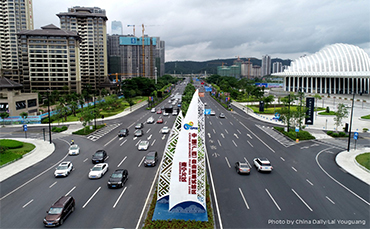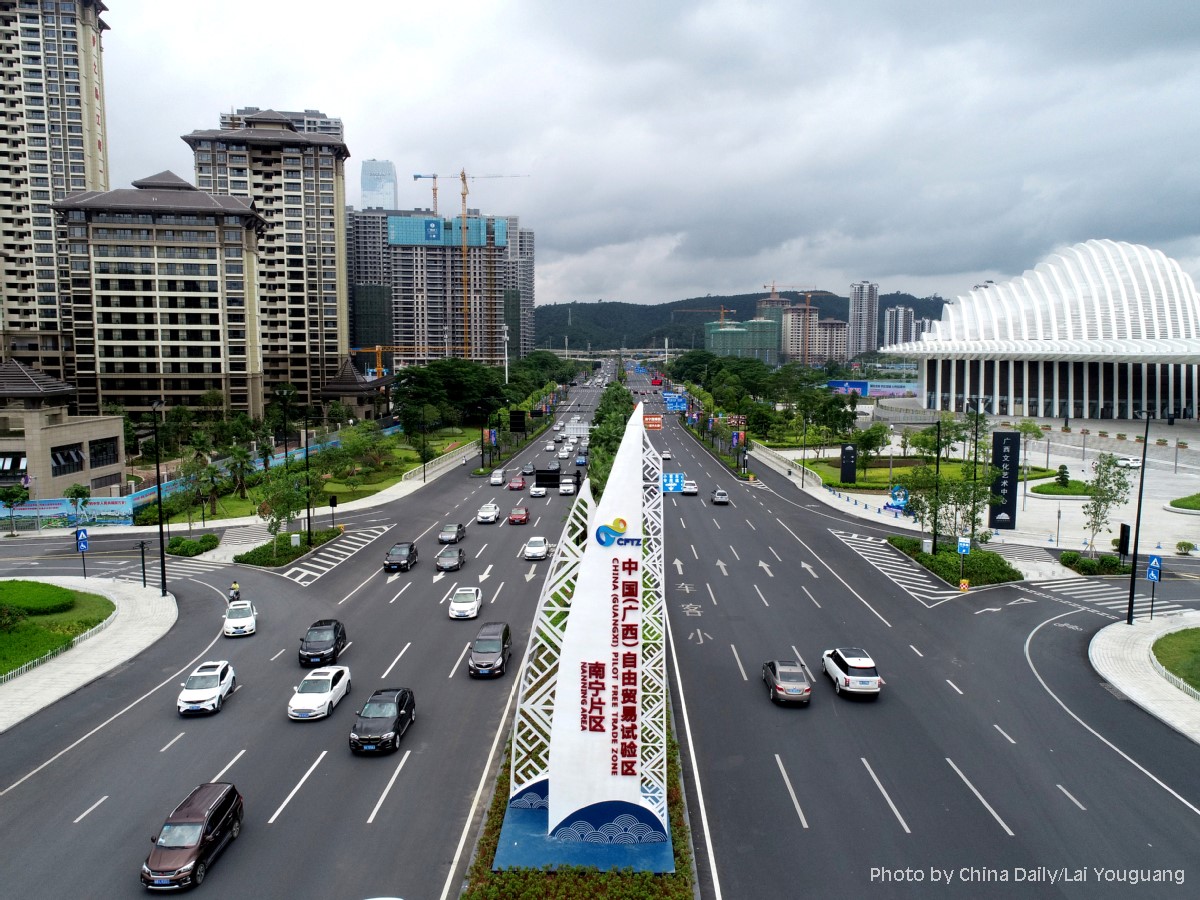



The China (Guangxi) Pilot Free Trade Zone. [Photo by China Daily/Lai Youguang]
7. INTENSIFY THE TWO-WAY OPENING-UP
Make new strides toward building a closer China-ASEAN community with a shared future, devote to the construction of the Belt and Road, strengthen the docking with major regional strategies, and deeply serve and integrate into the new development paradigm.
Co-build a cooperation highland opening to ASEAN. Pursue high-standard implementation of the Regional Comprehensive Economic Partnership (RCEP) agreement, encourage enterprises to make good use of preferential tariff treatment, the cumulation of origin, and other rules under the RCEP framework, and cooperate with RCEP members, especially the Southeast Asian countries, to build cross-border industry chain and supply chain of electronic information, new energy vehicles, home appliances, machinery, and equipment, etc. Promote the construction of comprehensive pilot zones for cross-border e-commerce, develop international postal and courier services, and support the establishment of a number of overseas warehouses. Implement the negative list system for cross-border trade in services. Carry out China-ASEAN bilateral local currency business, and build a yuan-denominated commodity pricing and trading platform for ASEAN. Deepen the cooperation in science and technology with ASEAN countries in the fields of 5G, artificial intelligence, telemedicine, and big data. Make more efforts to participate in Lancang-Mekong Cooperation and BIMP-East ASEAN Growth Area. Foster cultural industries such as cultural creativity and animation and games to ASEAN to encourage private cultural exchanges.
Promote the construction of opening-up channels. Construct a seaward coverage network for all the key ports for ASEAN, leverage the advantages of the New Land-Sea Corridor in West China, actively develop a sea-rail intermodal transport system of the Silk Road Economic Belt and the 21st Century Maritime Silk Road, and build a highland of opening-up. Set up China-ASEAN multimodal transport alliance. Operate air routes to South Asia and Southeast Asia, strengthen the leading role of the Nanning Airport Economic Demonstration Zone, and promote the joint construction of the "Air Silk Road". Promote the construction of the China-ASEAN Information Port and further the application of Beidou technology for ASEAN countries to jointly build the "Digital Silk Road".
Build an open platform with a high standard. Accelerate the construction of open platforms including Haikou Jiangdong Software Park and Hainan Ecological Software Park, and support the import and export policies for the pilot zone of the Yangpu Bonded Port Area to further expand. Build the China (Guangxi) Pilot Free Trade Zone with high quality, replicate and promote the achievements of institutional innovation, and give greater reform space. Promote the high-quality development of comprehensive bonded areas while improving the systems and mechanisms of key development and open pilot zones such as Dongxing and Pingxiang. Build a high-quality International Medical Open Pilot Zone in Fangchenggang to promote medical and cultural exchanges and cooperation. Organize China-ASEAN Expo, China-ASEAN Business and Investment Summit, China International Consumer Products Expo, and so on.
The construction of the cluster should be connected with the development of the Yangtze River Economic Belt, the construction of the Guangdong-Hong Kong-Macao Greater Bay Area, and other major regional strategies. Bolster the precise docking of the industries and cooperation in science and technology talents, develop the enclave economy, support the Institute of Studies for the Guangdong-Hong Kong-Macao Greater Bay Area to establish new types of research and development institutions in the Beibu Gulf urban cluster, and build a base for the transformation and application of technological innovation achievements. Strengthen the cooperation with the Chengdu-Chongqing Economic Circle and the urban agglomeration in the middle reaches of the Yangtze River in the fields of machinery manufacturing, new materials, biomedicine, electronic information, etc., and promote the joint construction of industrial parks and export bases in the Beibu Gulf. Support the orderly exit of heavy chemical industries along the Yangtze River, and build advanced production bases in the coastal areas of Beibu Gulf under the principle of capacity replacement.
8. IMPROVE THE JOINT CONSTRUCTION AND SHARING OF PUBLIC SERVICES
Adhere to put people front and center, optimize the allocation of public resources within the urban cluster, and continuously improve the quality and convenience of public services to jointly realize a happy Beibu Gulf.
Improve the quality of education and culture. Expand the capacity of urban and rural schools, promote high-quality, well-balanced development and urban-rural integration of compulsory education. Make vocational education more adaptive, and encourage to establish a modern vocational education system that is compatible with industrial development and port operations to promote educational communication and collaboration with ASEAN. Promote the co-building of Hainan University and Guangxi University by ministries and provinces, enhance the quality of Guangdong Ocean University and Beibu Gulf University, support the construction of Hainan International Education Innovation Island, and reinforce the exchange and cooperation among universities within Beibu Gulf urban cluster while providing a series of key academic subjects with the China-ASEAN regional influence. Support the Sea Route of Silk Road: Historic Sites along the Beibu Gulf Coast to nominate for the World Heritage Lists. Besides, promote the integration of regional tourism brands and relevant services.
Keep enhancing public services. Strengthen the primary-level public health systems, develop the regional medical consortia, support to establish the high-ranking hospitals at the provincial level, and improve the mechanism in terms of mutual recognition for medical test results and the flexible inter-hospital patient transfer. Develop elderly care services with regional characteristics based on the ecological resources and advantages, and construct some regional health and elderly care services demonstration bases. Put more effort into developing public-interest childcare services through multiple channels. Expand the inter-city cooperation of laborers even further and carry out targeted vocational skills training. Deepen the regional public service information sharing and provide the information of government services without departmental barriers and can be easy to access on an inter-provincial basis. Facilitate the transfer of social security such as medical care, old-age pension, unemployment, and other insurances across provinces and regions, and set up a labor dispute settlement mechanism to protect the legitimate rights and interests of workers.
9. IMPROVE THE SECURITY SYSTEM
Coordinate development and security, prevent various risks and challenges, improve public security system and mechanism, shore up the weak links in security infrastructure, ensure the energy resource, and strengthen the ability to deal with risks.
Build a vital energy resource storage and transportation base in the southern part of China. Relying on the coastal fuel ports such as Qinzhou and Maoming as well as the Beihai LNG terminal, build offshore gas terminals and oil and gas storage and transportation bases to play exemplary roles within the surrounding areas. Pursue greater connectivity of grids and steadily advance the exploration and development of oil and gas resources and natural gas hydrates in the South China Sea. Expand the import of resource products, develop the commodity distribution and trade such as crude oil, ore, coal, and grain and relevant supply chain services, strengthen international exchange and cooperation with ASEAN countries, and promote the construction of commodity delivery warehouses.
Intensify the risk prevention and control system of the Beibu Gulf urban cluster. Improve the integrated prevention and response mechanism for major disasters and emergencies, and make greater efforts to train emergency rescue personnel while strengthening equipment allocation and stockpile. Improve and implement the safety production responsibility system and jointly build the emergency rescue base of hazardous chemical production in the Beibu Gulf. Upgrade the coordination mechanism of monitoring and prevention for coping with major public health emergencies and build a national emergency medical rescue base as well as a platform for anti-pandemic supplies in the Beibu Gulf. Enhance capabilities in flood and typhoon prevention and control systems, and fully strengthen the construction of urban flood control and drainage facilities. Improve backup lifeline facilities in terms of water, power, gas, and communication, speed up the upgrade of aging drainage pipelines, strengthen the public firefighting facilities, improve natural disaster monitoring and prevention, and enhance emergency response capacity for natural disasters and nuclear security. Improve the mechanism for resolving tensions and joint handling of cases, intensify the security management of the migrant population and build a safe Beibu Gulf.
Source:
<https://www.ndrc.gov.cn/xxgk/zcfb/tz/202204/P020220413606025490548.pdf>
<http://english.www.gov.cn/policies/latestreleases/202203/23/content_WS623ae22cc6d02e53353282d0.html>
<https://govt.chinadaily.com.cn/index/specials/beibugulf2019>
Edited and translated by GUO Xinxin